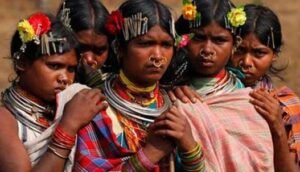
Why in News?
-
The Ministry of Tribal Affairs (MoTA) has asked the Census Commissioner to enumerate Particularly Vulnerable Tribal Groups (PVTGs) separately in the upcoming Census.
About Particularly Vulnerable Tribal Groups (PVTGs)
Who They Are?
-
A sub-category of Scheduled Tribes (STs) identified as the most disadvantaged among tribal communities.
-
Origin of concept: Dhebar Commission (1960–61) recommended focused attention on groups facing extreme backwardness.
-
Identification:
-
Initially 52 groups identified in the 5th Five-Year Plan (1974–79).
-
Later 23 more added in 2006.
-
Total 75 PVTGs at present.
-
Habitat
-
Spread across 18 states and the Andaman & Nicobar Islands.
-
Mostly inhabit remote forests, hilly terrains, and islands with very limited infrastructure.
-
Examples:
-
Baigas (Madhya Pradesh & Chhattisgarh)
-
Abujh Marias
-
Jarawas
-
Onges
-
Sentinelese
-
Shompens
-
Key Characteristics
-
Demography: Declining or stagnant population, making them highly vulnerable.
-
Geography: Geographical isolation and minimal contact with mainstream society.
-
Economy: Dependence on pre-agrarian practices such as hunting, gathering, and shifting cultivation.
-
Social indicators:
-
Low literacy
-
Poor health outcomes
-
Economic backwardness compared even to other Scheduled Tribes
-
-
Culture: Distinct social and cultural practices preserved due to isolation.
Need for Separate Enumeration in Census
-
Previous Censuses did not enumerate PVTGs separately; they were merged under the general ST category.
-
Benefits of separate enumeration:
-
Provide exact population and socio-economic details for better targeting.
-
Help design and monitor schemes in health, education, and livelihoods.
-
Identify infrastructure gaps in habitations for programs like PM JANMAN (₹24,104 crore, launched in 2023).
-
Support protection of habitat rights and preservation of unique cultures.
-
Reassess whether current PVTG criteria remain relevant, since some groups may have progressed while others have declined.
-
विशेष रूप से कमजोर जनजातीय समूह (PVTGs):
समाचार में क्यों?
-
जनजातीय कार्य मंत्रालय (MoTA) ने आगामी जनगणना में विशेष रूप से कमजोर जनजातीय समूहों (PVTGs) की अलग से गणना करने के लिए रजिस्ट्रार जनगणना आयुक्त से अनुरोध किया है।
विशेष रूप से कमजोर जनजातीय समूह (PVTGs) के बारे में
ये कौन हैं?
-
अनुसूचित जनजातियों (STs) की एक उप-श्रेणी जिन्हें जनजातीय समुदायों में सबसे अधिक वंचित माना गया है।
-
अवधारणा की उत्पत्ति: धेबर आयोग (1960–61) ने अत्यधिक पिछड़ेपन का सामना कर रहे समूहों पर विशेष ध्यान देने की सिफारिश की।
-
पहचान:
-
प्रारंभ में 5वीं पंचवर्षीय योजना (1974–79) में 52 समूहों की पहचान हुई।
-
बाद में 2006 में 23 और जोड़े गए।
-
वर्तमान में कुल 75 PVTGs हैं।
-
आवास
-
18 राज्यों और अंडमान एवं निकोबार द्वीप समूह में फैले हुए।
-
मुख्य रूप से दूरस्थ जंगलों, पहाड़ी क्षेत्रों और द्वीपों में रहते हैं जहाँ बुनियादी ढांचा बहुत सीमित है।
-
उदाहरण:
-
बैगा (मध्य प्रदेश एवं छत्तीसगढ़)
-
अबूझ मरिया
-
जरावा
-
ओंगे
-
सेंटिनलीज़
-
शोंपेन
-
मुख्य विशेषताएँ
-
जनसांख्यिकी: घटती या स्थिर जनसंख्या, जिससे ये अत्यधिक असुरक्षित हैं।
-
भौगोलिक स्थिति: मुख्यधारा समाज से न्यूनतम संपर्क और भौगोलिक अलगाव।
-
अर्थव्यवस्था: शिकार, संग्रहण और झूम खेती जैसी पूर्व-आर्थिक गतिविधियों पर निर्भरता।
-
सामाजिक संकेतक:
-
कम साक्षरता
-
खराब स्वास्थ्य परिणाम
-
अन्य अनुसूचित जनजातियों की तुलना में भी आर्थिक रूप से पिछड़े
-
-
संस्कृति: अलगाव के कारण विशिष्ट सामाजिक और सांस्कृतिक प्रथाएँ संरक्षित।
जनगणना में अलग गणना की आवश्यकता
-
पिछली जनगणनाओं में PVTGs को अलग से नहीं गिना गया, इन्हें सामान्य ST श्रेणी में शामिल किया गया।
-
अलग गणना के लाभ:
-
बेहतर लक्ष्य निर्धारण के लिए सटीक जनसंख्या और सामाजिक-आर्थिक विवरण प्रदान करना।
-
स्वास्थ्य, शिक्षा और आजीविका से संबंधित योजनाओं की रूपरेखा बनाने और निगरानी करने में मदद।
-
PM JANMAN (₹24,104 करोड़, 2023 में शुरू) जैसी योजनाओं के लिए उनके आवास क्षेत्रों में बुनियादी ढाँचे की कमी की पहचान।
-
आवासीय अधिकारों की रक्षा और विशिष्ट संस्कृतियों के संरक्षण में सहयोग।
-
यह पुनर्मूल्यांकन करना कि मौजूदा PVTG मानदंड अब भी प्रासंगिक हैं या नहीं, क्योंकि कुछ समूह आगे बढ़े हैं जबकि कुछ और पिछड़ गए हैं।
-




